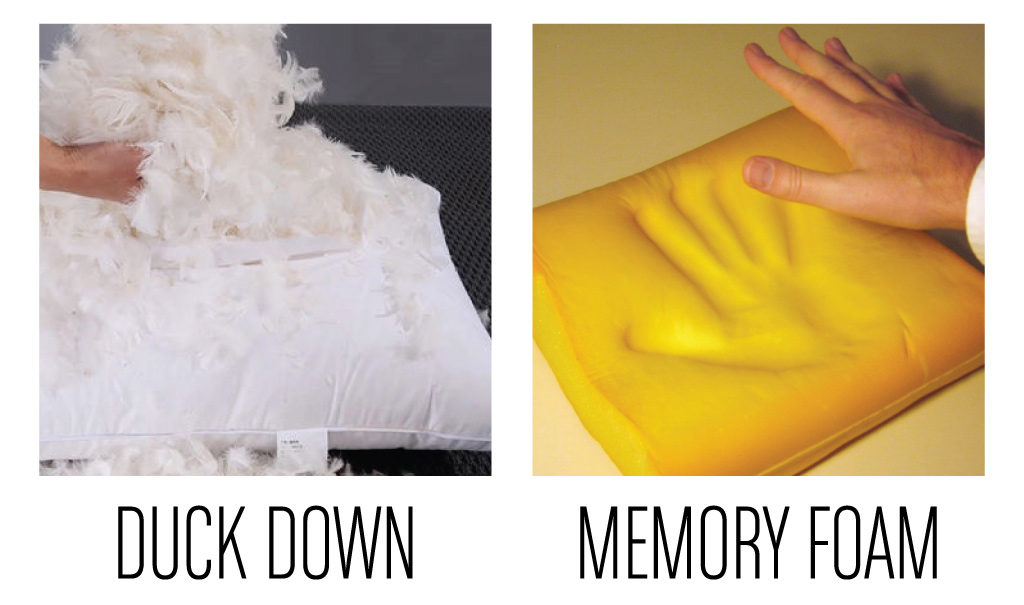AlsoHave you ever been shopping for a new pillow and been floored by just how many styles, shapes, and varieties there are for something so simple and necessary? You’re not alone: many people take their pillow for granted and don’t consider how complex they are. Though you may think otherwise, it’s not a simple matter of being too soft or too firm, and understanding precisely what a pillow’s job is and how it performs said job will help ensure your next purchase is the right one for you.
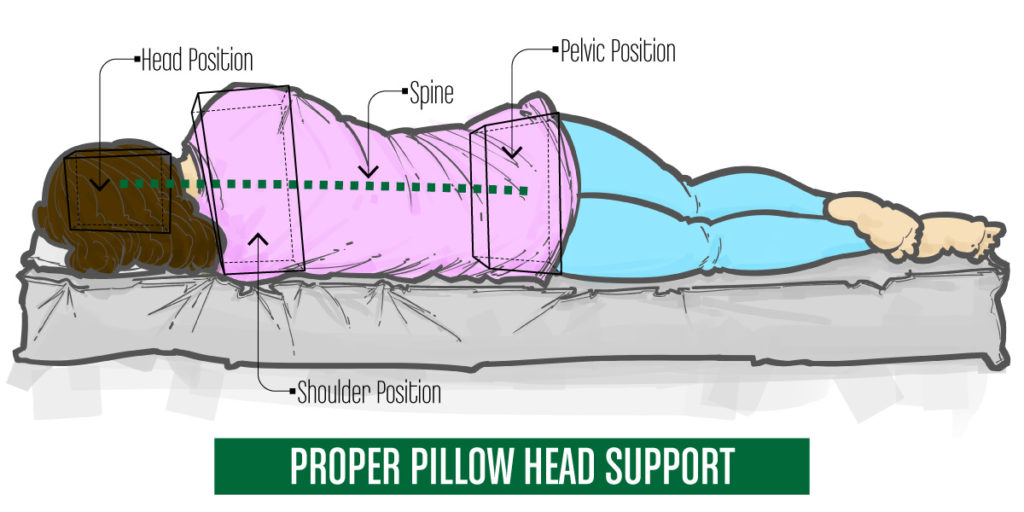
But what makes a pillow “right” for you? A good pillow will support your head in such a way that it keeps your neck, shoulders, and spine in proper alignment. Doing so helps eliminate pressure points and allows you to rest more comfortably. However, multiple factors influence how well any particular pillow will work for you.
We’ve written this guide to help take the confusion and guesswork out of pillow shopping. We’ll start by going into greater detail about what a pillow is supposed to do, how your sleep habits dictate which pillows are the best for you, and how to get the most support out of them when it comes time for bed. So slip into some nice pajamas, pour yourself a cup of tea, pull up the covers, and snuggle in with our perfect pillow guide.
The Noble Work of the Pillow
As stated in the intro, a pillow works to maintain your body’s proper alignment when you’re sleeping. You may not be able to see when you’re out of alignment (just who can see their own neck and spine, anyway?), but you’ll certainly feel it: pain in your neck is a strong signal that one of those three components is out of whack. With that in mind, your pillow does much more than give you a nice cozy place to prop your head.
When presented like that, it all seems so simple, right? But if that were truly so, you could make do with any old pillow at all. Instead, different elements must be considered about the pillow itself as well as your sleep needs and even your bed.
First, let’s look at what makes a pillow a pillow. Regardless of the materials used to make it (which we will go over later in this piece), your chosen pillow should comfortably keep your neck, shoulders, and spine in neutral alignment while supporting your head. These two functions work hand in hand and are fulfilled by two key characteristics of the pillow.
One is its loft. This refers to the pillow’s thickness when it is resting on a flat surface. A high loft pillow will be thicker while a low loft pillow will be thinner.
Easy, right? Determining the loft of a pillow isn’t an exact science—as in, manufacturers don’t use a universally agreed-upon set of measurements to determine what is high or low—and are generally sold with high, medium, and low labels. When you know which one works well for you, it makes the process of buying future pillows that much easier: though what “low loft” means may differ from one manufacturer to another, you can look at the size (and the feel—more on that in a moment) to determine if what you’re looking at is a match.
The second key characteristic is a pillow’s firmness. This is how strong the pillow is, or how it reacts to applied weight. Think of it as how flat a pillow goes when you rest your head on it.
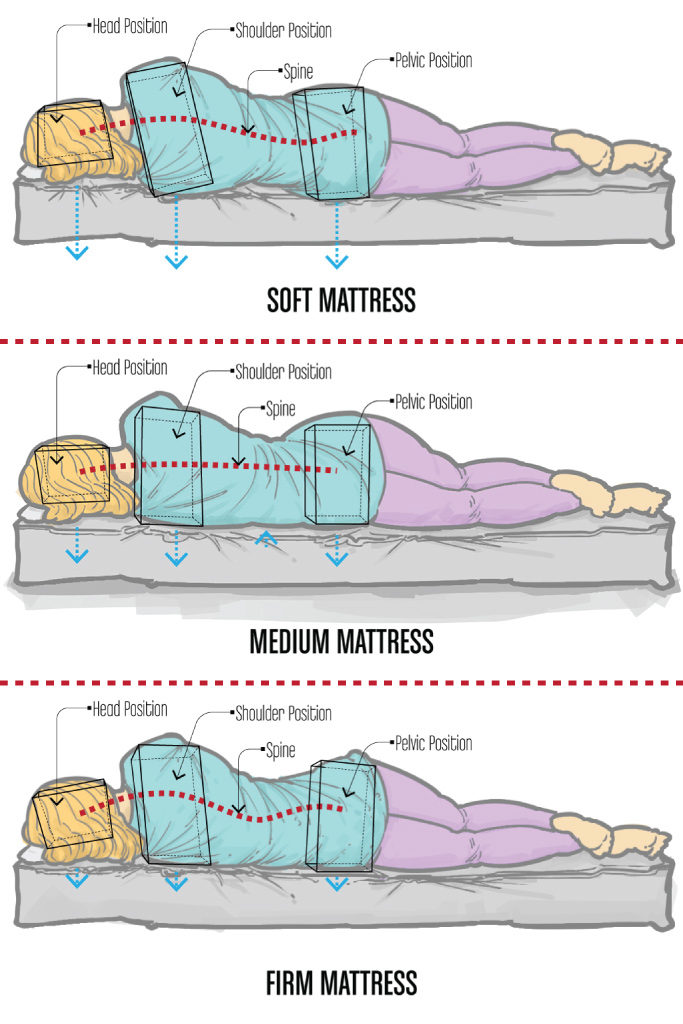
The resistance is necessary to support your head, which in turn removes pressure from your neck. Though this may sound similar to loft, the two work independently. The low loft pillow can be very firm and a high loft pillow can provide little support by comparison. It largely comes down to the materials used for the pillow’s filler.
So what is the importance of loft and firmness? Finding the correct mix between the two is how your spine, neck, and shoulders will stay aligned throughout the night and prevent unnecessary aches and pains. But a bad combination—either incorrect loft, incorrect firmness, or both—will make falling asleep difficult and create pressure points along with the misaligned areas.
With all of that said, the question becomes determining what combination you need. To begin answering this question, you must first look at how you sleep.
Your Sleep Position and Your Pillow
As you may have surmised, sleep position refers to how you lie in bed when you are asleep or trying to fall asleep. There are three positions: back sleeping, side sleeping, and stomach sleeping. Each one requires different forms of support to achieve correct spinal alignment.
Remember that ideal spinal alignment keeps your shoulders, neck, and back in line with each other. Now picture what you look like resting on your side, your back, and your stomach. Each position puts those parts in a different place, requiring different types of support to keep them well balanced.
If you’ve read our mattress firmness guide, this probably sounds familiar to you. That’s because a mattress and pillow function similarly in regards to firmness. The pillow, working side-by-side with your mattress, needs to compliment each position differently.
For example

If you’re a back sleeper your best bet is a pillow that offers both medium loft and firmness. The medium loft will put enough space between your head and the bed itself to keep your shoulders and neck supported without creating pressure points. The low loft may leave your neck bent awkwardly backward, and high loft may force it forward, creating stress and pain either way. Medium firmness allows your head to sink into the pillow somewhat before its density pushes back.
 Side sleepers require more loft and firmness, by comparison, to compensate for how high their neck is above the mattress while still maintaining spinal alignment. A high loft pillow will be taller, closing the gap between the head and mattress, while having more firmness will support the head with only minimal give, preventing the weight from causing the pillow to collapse and bend the neck as you sleep.
Side sleepers require more loft and firmness, by comparison, to compensate for how high their neck is above the mattress while still maintaining spinal alignment. A high loft pillow will be taller, closing the gap between the head and mattress, while having more firmness will support the head with only minimal give, preventing the weight from causing the pillow to collapse and bend the neck as you sleep.

Finally, stomach sleepers. Though they are the least common of the three positions (and the only one discouraged by medical professionals), some people just feel more comfortable sleeping this way, and they need alignment just as much as everyone else. Not surprisingly, they want a pillow that is on the low end of the spectrum in both areas since they have the least impact on your spine’s curve. Since you’re lying flat on your stomach, your spine, neck, and shoulders will be close to aligned without much help from a pillow.
The above principles are all sound on their own but may need to be adjusted slightly depending on the bed you sleep on.
Mattress Matters
Previously we discussed how the firmness of a mattress impacts spinal alignment. To go into greater detail, the less firm a mattress is, the more it will allow your body to sink into it, complimenting the side sleeping position. A firm mattress, by comparison, offers little give and keeps the body level, which is better for back and stomach sleepers.
Besides compensating for your body position, your pillow may need to compensate for the firmness of your mattress depending on how extreme it is. A softer mattress will bring your head closer to the mattress, so thinner pillows are best to keep things aligned. A firmer mattress will benefit from a thicker pillow.
Those are the nuts and bolts of what a pillow should do and what factors determine comfort. While these all have a solid basis in physical well-being, there is a degree of personal preference that comes into play as well. It may be best to view these as general guidelines and not hard rules.
It’s What’s Inside That Counts
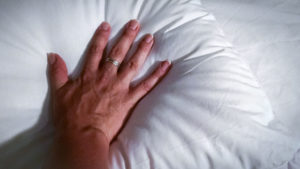 Now that we’ve covered the what of pillows, let’s dive into the how. What gives a pillow its firmness and provides the comfort you need to get a great night’s sleep? That would be the filling—literally what’s inside of the pillow itself. Sometimes called stuffing, the make of the filling itself not only gives your pillow strength but determines several other factors as well, including how easy or difficult it is to clean, how well it regulates heat, and to what degree you can reshape it, among other things.
Now that we’ve covered the what of pillows, let’s dive into the how. What gives a pillow its firmness and provides the comfort you need to get a great night’s sleep? That would be the filling—literally what’s inside of the pillow itself. Sometimes called stuffing, the make of the filling itself not only gives your pillow strength but determines several other factors as well, including how easy or difficult it is to clean, how well it regulates heat, and to what degree you can reshape it, among other things.
The filling is where much of the confusion of pillow shopping comes in. Much like mattresses, manufacturers make use of many different materials to achieve different effects, and while the differences may seem minute, the underlying complexities will make or break your sleeping experience. Let’s take a moment to do a deep dive into the most commonly used filling and what makes them unique.
A note before continuing: when we talk about pillows, “fill” is not the same thing as “filling.” This will be explained below.
Synthetic filling
These are very easy to find, and for many good reasons: they’re easy to clean, they’re hypoallergenic, and they are cheap to produce and buy. Synthetic filling seeks to mimic the look and feel of cotton, and as a result makes for a lightweight, easy to mold pillow. These qualities make it popular with hospitals and hotels.
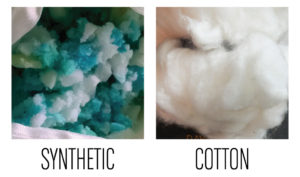 While synthetic pillows can provide all levels of support as needed, the material itself tends to give away comparatively quickly. Through repeated use the material flattens and clumps together, reducing the pillow’s loft and cutting back how much support it gives. These factors lead to it losing its shape as well, making reshaping and folding the mattresses necessary but eventually futile. The shelf life of the average synthetic pillow is only half a year.
While synthetic pillows can provide all levels of support as needed, the material itself tends to give away comparatively quickly. Through repeated use the material flattens and clumps together, reducing the pillow’s loft and cutting back how much support it gives. These factors lead to it losing its shape as well, making reshaping and folding the mattresses necessary but eventually futile. The shelf life of the average synthetic pillow is only half a year.
Cotton filling
This is what most of us think of when we think pillows: big, squishy, and lightweight. They bear some similarity to a synthetic filling but are better at cooling down and regulating heat. Washing them is also a simple task.
Cotton overtime will bunch together and create noticeable lumps in the pillow, not unlike a synthetic filling, leading to many of the same problems that those pillows have. However, one of the main advantages that synthetic and cotton pillows have is that you can adjust the amount of filler or even replace it with new cotton to change its loft or breathe new life into them at a very low price.
It’s also worth noting that cotton is more difficult to mold than other options and doesn’t retain its shape very well.
Down filling
Not to be confused with feathers, down is the underside of the feather, the part that tends to be the softest. Unlike feathers themselves, down has an appearance like a cluster, with the soft fibers “bursting” out from the center. This structure lends itself to a pillow having greater volume, resulting in more loft. They can easily be reshaped and maintain a nice, cushioned feeling. Down structure allows it to spring back to shape, giving it a longer lifespan than feathers.
But all of these great qualities come at a price, and for down pillows, it can be a hefty one. Depending on where you shop, the brand, and other factors, a down pillow can cost over one-hundred dollars, at least twice as much as their feather counterparts on average. What’s more, down can make a night’s sleep difficult for those who prefer to keep cool, since down traps heat.
Finally, down is difficult to care for. Cleaning instructions need to be closely followed. Again, this is where choosing the right pillowcase can prevent the need for much maintenance.
Feather filling
Though down is often bandied about as being superior to feathers as a pillow filler, feathers do shine in a few areas where down do not. Specifically, they are initially softer and easier to mold into a preferred shape. This is done through fluffing, though this won’t prevent them from totally losing form.
Feather’s weaknesses, however, outweigh its strengths for many. Because the feathers compress together, they fail to achieve much loft, and when paired with how little resistance they offer as a material, the pillow itself doesn’t offer a great deal of distance between your head and the mattress. Feather pillows also have poor airflow because of how the flat feathers press together.
A problem unique to feather pillows entirely is the hazard presented by quills. No matter what sort of pillowcase you use, there is always a risk that your weight will force the quills through, leaving them to scratch or poke at your face. Since fluffing only increases the odds, but is necessary to maintain the pillow’s loft, there isn’t a whole lot you can do to prevent this.
Feathers can be an allergen for some (as can down), but even if you aren’t allergic they are known to have odor issues. This is especially true when they get wet and don’t dry properly.
Memory foam
Memory foam was originally developed by the fine folks at NASA to make the cushions inside of aircraft safer in emergencies. Since its introduction, it has become a popular material used for both mattresses and pillows. Formerly a luxury item, memory foam pillows can now be purchased in most big box stores.
As a pillow, memory foam is much beloved for its softness and density. It allows your head to rest and sink into the pillow. Using your body heat, it molds itself to your contours, creating a uniquely perfect fit for each user. When not in use, the foam springs back to its original shape.
Because it uses heat to match the shape of your neck and skull, memory foam doesn’t ventilate well, which may lead some to become too warm while they are sleeping. Additionally, though they are widely available to consumers, memory foam pillows are still very expensive due to the process and materials used to manufacture them. They are among the most costly pillows on the market.
Then there’s off-gassing. This refers to the strong (though temporary) chemical odor released by memory foam. The smell itself is a result of the compounds used in the manufacturing process, and while it fades after six or so weeks, the smell can cause headaches and irritation in the eyes, nose, and throat. It hasn’t proven to be dangerous, but it’s worth noting.
Shredded memory foam
Though it molds to your contours, memory foam can’t be reshaped like feathers or cotton. It’s heavy and can’t be adjusted without physically cutting pieces of it off (and honestly, don’t you think it’s a bit extreme to carve up your bedding?). Shredded memory foam succeeds in addressing this problem.
Being torn into smaller pieces allows for the pillow to be adjusted like cotton or feathers, so you can squish it to your heart’s content if you need more loft. The other problems with memory foam still exist in its shredded form, but one requires special attention: the thinner pieces flatten quicker as they absorb heat. You may not get the same degree of support as you would from a regular memory foam pillow, even if you mold it.
Shredded memory foam is available for purchase online, but few manufacturers use it to make pillows themselves. If you’re the crafty type, you can make your pillow with loose foam as the filler.
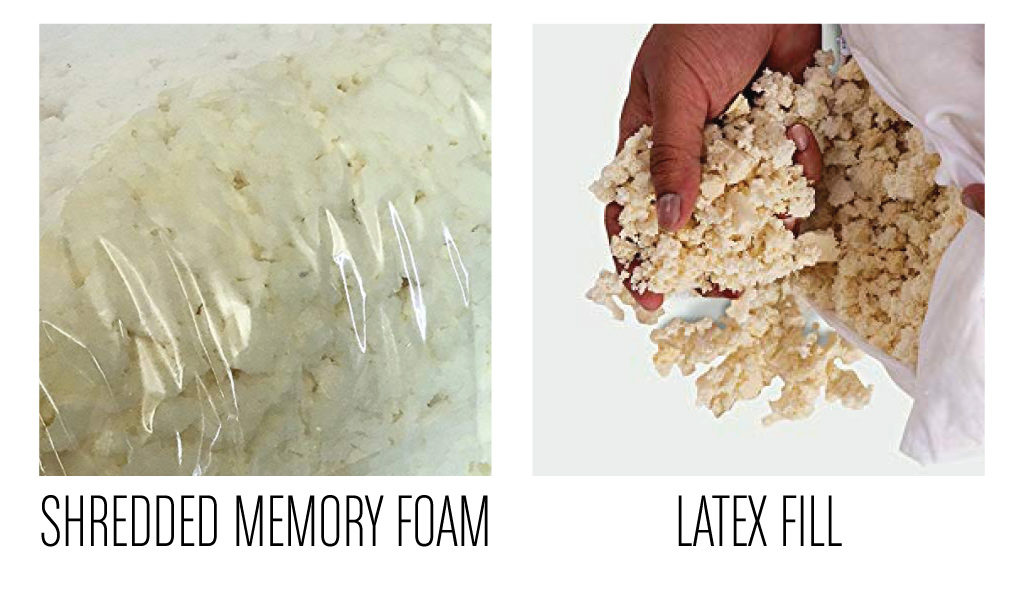
Latex filling
Latex is seen as the all-natural alternative to memory foam. Also, Latex is incredibly popular both for its similarities to memory foam as well its lower price. The pillow itself comfortably molds to your neck and head, sharing some of the same pain-relieving qualities as memory foam.
It’s biggest draw is that latex isn’t as dense as memory foam, which makes it better at cooling down. If you find that your current pillow warms up too quickly or too much, latex could work better for you than memory foam.
Despite popular misconception, there is no off-gassing with latex. It does, however, have a (sometimes strong) odor that fades in a few weeks. This is from the latex itself, not chemicals, and isn’t known to be dangerous.
The drawbacks of latex are the same as memory foam. Though they cost less, they are still quite expensive compared to other pillows on this list. They also can’t be adjusted because the latex is produced in a singular block. There’s no reshaping latex without tearing it to pieces.
Microbead filling
Being malleable is one of the biggest advantages a pillow can have, but natural fillers pose allergen risks. Synthetic options like microbeads are a great substitute. Because the artificial beads are so small, it’s easy to fluff and adjust your pillow to meet your comfort needs.
They also can mold to your contours in a way that’s similar to memory foam. Unlike their space-age counterpart, microbead pillows are highly breathable and have no problem keeping cool.
The downside of microbead pillows is that they have a very short shelf life. The beads have to be soft to be comfortable but offer so little resistance that they flatten quickly and permanently over time. Whereas memory foam can spring back to life, again and again, microbeads give up the ghost rather quickly.
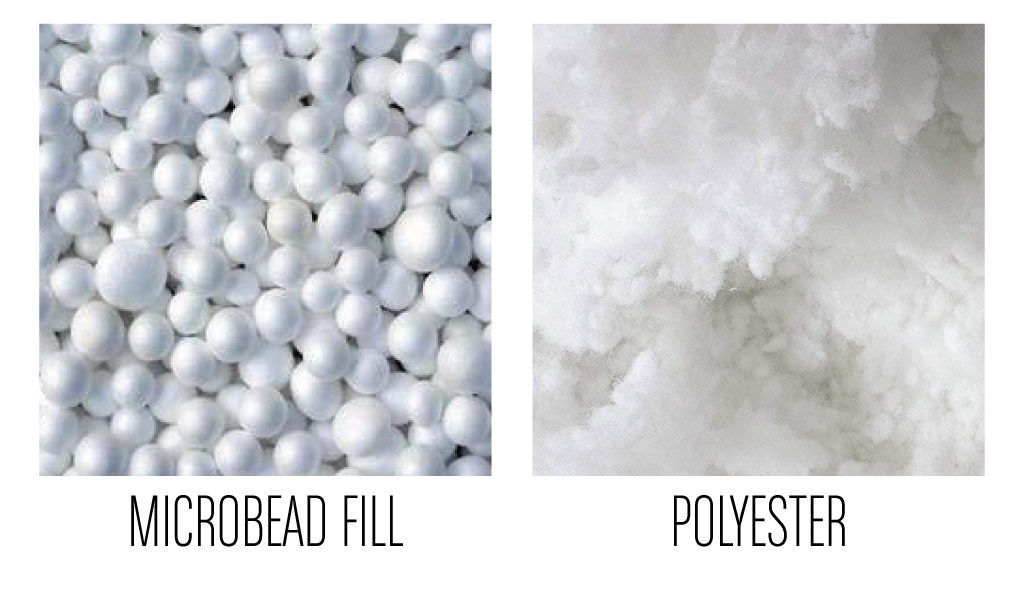
Polyester filling
Of all the man-made options, polyester filling (also known as Poly-Fil) is the least expensive, resulting in pillows that can fit comfortably in any budget. Polyester pillows are made in all lofts and firmness levels and can be molded with ease. Being hypoallergenic is another one of their strengths.
That said, when something is inexpensive you shouldn’t expect it to last very long. Polyester pillows lose shape quickly until eventually, they are flat and lifeless. Polyester also tends to bunch together, making your pillow lumpy. For all of the good that simple polyester pillows do, they need to be replaced more frequently than most other pillows.
Buckwheat hull filling
The use of buckwheat hulls in pillows is growing among those who want an all-natural fill that’s both firm and malleable. While it’s great at molding to the contours of your neck and head, the hulls themselves do not squish or lose form. The hulls allow for good airflow, so heat doesn’t get trapped inside.
They do have the dubious honor of being among the loudest pillows on the market. Moving the pillow even slightly causes the hulls to rustle and rattle about. This isn’t a problem if you don’t toss and turn throughout the night, or if you don’t need to reshape your pillow as the night goes on.
The hulls also mean the pillows are naturally firm and cannot be made softer. You can remove or add hulls to increase or decrease loft, but that won’t change how firm the pillow can be. Its malleable qualities make it so that the hulls don’t create pressure points despite this, but it’s still something that may take time to adjust to if you’re used to softer types of filler.
Fill vs. Filling
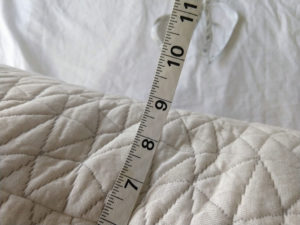 If you’re shopping for pillows and see the word “fill” as part of a product description, you’re looking at a down pillow. Fill power is unique to down and describes how much space a single ounce of down clusters fill when at their peak loft. This is measured in cubic inches as fill power: four-hundred fill power means the pillow contains four-hundred cubic inches of down.
If you’re shopping for pillows and see the word “fill” as part of a product description, you’re looking at a down pillow. Fill power is unique to down and describes how much space a single ounce of down clusters fill when at their peak loft. This is measured in cubic inches as fill power: four-hundred fill power means the pillow contains four-hundred cubic inches of down.
Even though it’s unique to down pillows, it’s important to know what fill power does and doesn’t mean. The more fill power a pillow has, the greater its loft and the softer it feels. It also traps more heat than lower fill power. Higher fill power sees the down clusters retaining their firmness and loft for longer periods, either because the clusters are larger or there are more of them.
Fill power does not equate to a heavier pillow, nor does it necessarily make for a firmer pillow. These are determined by the density of down used as a filling. As a result, pillows stuffed with larger down clusters can be lighter than those with smaller clusters.
When to Replace Your Pillows and Why
In the descriptions above loft and firmness were heavily discussed because they are the elements that make your pillow useful. Once your pillow reaches a point where it has no resistance and can’t maintain shape, it’s a goner. But should you bother waiting that long?
Each filling has its own generally recognized lifespan, after which it can no longer adequately support your head and neck, failing to provide good spinal alignment. Some manufacturers include the expected lifespan with their pillows, and guides online estimate how long each filler can be expected to last (on our list, latex is the most durable with three years, feathers the least with nine months, and the others range from one to three years with only slight variations). But going by these guidelines will always be something of a gamble because your sleep environment and how you maintain your pillow can extend or shorten its longevity greatly.
The point is, while it may be nice to know the general durability of your pillow’s materials, it’s not the best way to measure whether or not it’s performing well or needs to be retired. Instead of thinking that your pillow has a set amount of time, pay greater attention to how you feel when using it. It’s easy not to notice when a pillow is doing its job because you won’t feel any pain in your head, neck, or shoulders. Once you notice that pain creeping in, however, it’s time to investigate.
If you suspect that your once beloved pillow is losing its luster, you can tell if its lost loft by how thick it is. Pillows will flatten over time, losing their support and no longer holding you in your preferred position.
Fillers like cotton, down, and polyester—those that are comprised fully or partially of strands of fiber—can’t help but clump over time. This is immediately noticeable because you will be able to feel the density of lumps, and as a result, they will create pressure points when you’re trying to sleep. These lumps are a good sign that your filler (or your pillow itself) needs to be replaced.
You should also look for visual clues in the cleanliness of your pillow. While you’re snoozing your body produces all sorts of unpleasantness: shedding dead skin cells, sweat from your pores, and oil secreted from your hair. If you fail to wash your pillow regularly, these things can accumulate in garish stains that lock-in foul odors and can degrade the filler.
Perhaps you can mask these things with a good clean pillowcase if you’re feeling lazy, but there’s an even greater problem that you can’t see: dust mites. Though they don’t pose a direct threat to your health, they feed off the dead cells accumulating in your pillow and collect inside of it, cutting down its lifespan. Dust mites may also require you to replace pillows more often than normal if you have allergies.
Maximizing Your Pillow’s Lifespan
Given that you’ll have to replace pillows throughout your life, you’ll want to get as much use out of each one as you possibly can to save money. Doing so is just a matter of good upkeep and regular cleaning. You must follow the cleaning instructions very carefully, though, because not all materials will hold up to around in the washer and dryer, and improper cleaning will only cause more damage.
Another good practice is protecting your pillows. Pillowcases, while nice, aren’t always enough. Depending on the material, sweat and oil can still penetrate the case and seep into the pillow.
Some people use multiple pillowcases to create more protective layers for the pillow. It’s not a bad practice at all, but pillow covers are an even better solution. They go around the pillow and seal closed, usually with a zipper. They’re often made with a thicker material that’s more resistant to liquids, providing a strong defense for both the pillow and its case (or cases).
Covers and cases need to be cleaned more often than pillows. Again, follow the instructions.
If you find you aren’t comfortable with a pillow, particularly with how it feels against your skin or its heat, try changing the case and/or cover first. Like fillers, the fabrics of cases carry different properties that may disagree with you. Since cases and covers tend to be less expensive than pillows, trying out a few different types is a good step to take before blaming your discomfort on the pillow itself.
Fluffing a pillow doesn’t help its longevity, despite what we’ve all learned from television and movies. It’s useful for molding it and returning it to maximum loft, but it doesn’t help the filler’s support in any way. If you’re using a feather pillow, the need to constantly fluff is a sign that the feathers have broken down and lost their natural support.
Why Heat or Cool A Pillow?
People generally advocate for heating or cooling one’s pillow because it brings them additional comfort. A chilled pillow can help keep things cool when it’s unbearably hot outside. Both hot and cold pillows may help alleviate pain in the neck and the head (though if you find yourself waking up in the morning with a headache frequently, it could mean that your pillow needs to be replaced for any of the reasons listed above).
That’s the why, but what’s the how? It varies with the filler material, but for most options simply sticking the pillow in the refrigerator for a short while will keep it cool as you try to fall asleep. How long it retains its low temperature will vary with the filler itself, your body temperature, and the temperature in your bedroom.
Heating a pillow, on the other hand, is tricky. It’s recommended that you use a filler that traps your body heat rather than trying to heat one through other methods because of the potential fire hazard doing so creates. Placing a heating pad beneath your pillow is an exceptionally dangerous idea, and microwaving your pillow (no, really—some people do this) can be just as bad depending on what’s inside of it.
As a precaution, if the manufacturer doesn’t include heating instructions or recommend it at all, simply don’t try it. Success stories you may get from friends or online shouldn’t be taken as demonstrations of guaranteed safety. The risk isn’t worth the potential gain.
Folding a Pillow: Yay or Nay?
If you feel compelled to fold your pillow in any way, it’s a sign that you’ve either bought a pillow that is a poor match for your sleep posture, or that it’s lost its support and should be replaced.
 Let’s say you bought a pillow that’s either too thin or isn’t firm enough for you. Folding it over may seem like a good idea on paper because you’re doubling its thickness and increasing its support at the same time. However, except for some fillers like feathers, the natural resistance the pillow provides will try to spring it back into its original shape. Sure, your head will hold it down, but the pillow is still actively pushing against you, creating pressure.
Let’s say you bought a pillow that’s either too thin or isn’t firm enough for you. Folding it over may seem like a good idea on paper because you’re doubling its thickness and increasing its support at the same time. However, except for some fillers like feathers, the natural resistance the pillow provides will try to spring it back into its original shape. Sure, your head will hold it down, but the pillow is still actively pushing against you, creating pressure.
Now let’s imagine that your favorite pillow has gone flat but you feel compelled to keep using it. You fold it over to increase its thickness and support. Unfortunately, this does nothing to make the filler more supportive. Fold it as many times as you like, but the pillow will still be flat.
If you have to fold, it’s likely got to go. It should be noted, though, that sliding an arm under your pillow isn’t necessarily indicative of the same problems. Some people do this habitually because it feels more comfortable and natural to them, and it may have nothing to with the pillow’s support at all.
Should I Sleep Without A Pillow?
Some people experiment with and even advocate for sleeping without a pillow. Sometimes it’s done because of an uncomfortable pillow: they constantly wake up in pain and learn to go without a pillow as a remedy. Others believe that going without a pillow has health benefits that using one does not.
 The truth is, going without a pillow doesn’t have any measurable health benefits that outweigh the harm it can cause. It’s only advised for stomach sleepers because that position comes close to keeping the neck and spine aligned and neutral, though softer mattresses may interfere with that (your midsection, which carries much of your weight, can sink deep enough into the mattress to throw alignment out of wack—but stomach sleepers will want a firm mattress anyway). It isn’t necessarily better for people sleeping in that position, mind you, but they have the least potential to be hurt by it.
The truth is, going without a pillow doesn’t have any measurable health benefits that outweigh the harm it can cause. It’s only advised for stomach sleepers because that position comes close to keeping the neck and spine aligned and neutral, though softer mattresses may interfere with that (your midsection, which carries much of your weight, can sink deep enough into the mattress to throw alignment out of wack—but stomach sleepers will want a firm mattress anyway). It isn’t necessarily better for people sleeping in that position, mind you, but they have the least potential to be hurt by it.
Some circles promote the idea that forgoing the pillow at nighttime is the best way to relieve neck pain. This is demonstrably not true if you simply look at sleep positions. Side and back sleepers need head and neck support to get proper spinal alignment.
There hasn’t been much research regarding the potential benefits of not using pillows and for this reason its difficult to recommend. It also makes supporting arguments for going pillowless hard, despite the number of claims floating around that it can improve different aspects of physical health. While we do not recommend it, consult your doctor first if it’s something you want to try.
Despite the ambiguity surrounding any alleged benefits of the practice, enough about spinal health is known to argue against it unless your personal care provider thinks your health and situation warrant it.
It’s All About Elevation
Remember, the right pillow won’t make its presence known. When you rest your head against it you won’t feel pain or stress along your spine. At the end of the day, all of the information you can learn about what makes pillows effective boils down to how much elevation they give and how much you need. Recognize when it’s starting to lose form, and replace it as soon as it does. Your body will thank you!


